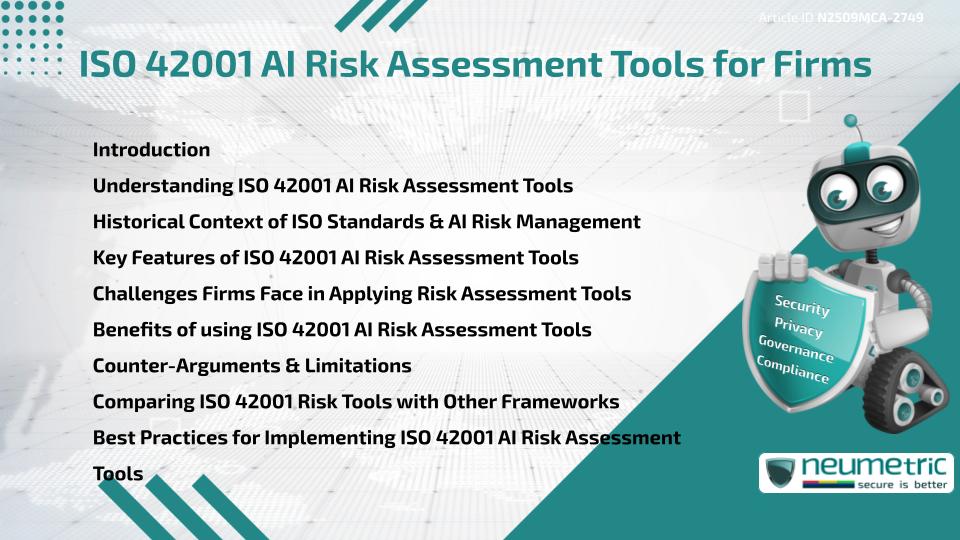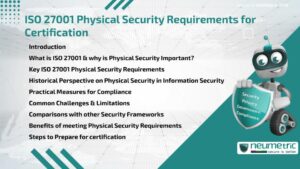Table of Contents
ToggleIntroduction
The ISO 42001 AI Risk Assessment Tools help firms identify, evaluate & manage the Risks associated with Artificial Intelligence [AI] systems. These Tools provide structured methods to assess Vulnerabilities, measure impacts & establish safeguards for compliance with ISO 42001. By using ISO 42001 AI Risk Assessment Tools, firms can ensure their AI Systems remain trustworthy, accountable & aligned with international standards.
Understanding ISO 42001 AI Risk Assessment Tools
The ISO 42001 AI Risk Assessment Tools are designed to guide firms through the systematic evaluation of AI-related Risks. They support Organisations in identifying ethical, operational & technical Risks while providing measurable indicators for decision-making. For firms, these Tools go beyond Regulatory Compliance-they create a Framework for sustainable & responsible AI adoption.
Historical Context of ISO Standards & AI Risk Management
ISO has a long tradition of developing standards that shape global Best Practices, such as ISO 9001 for Quality Management & ISO 27001 for Information Security. With the emergence of AI, ISO 42001 was developed to address Governance, accountability & Risk Management. Risk Assessment Tools within this Framework evolved to help Organisations manage the unique challenges posed by AI, including bias, opacity & rapid technological change.
Key Features of ISO 42001 AI Risk Assessment Tools
An effective ISO 42001 AI Risk Assessment tool should include:
- Risk identification methods: Frameworks to uncover ethical, security & operational Risks in AI Systems.
- Impact Assessment: Evaluating the severity of Risks on Stakeholders, processes & compliance obligations.
- Probability analysis: Measuring the Likelihood of identified Risks occurring.
- Mitigation strategies: Providing options for reducing or eliminating Risks through safeguards.
- Continuous Monitoring: Updating Risk Assessments as systems evolve or regulations change.
- Documentation: Maintaining transparent records to demonstrate accountability during audits.
Challenges Firms Face in Applying Risk Assessment Tools
Firms often encounter difficulties when applying ISO 42001 AI Risk Assessment Tools. These include limited resources, lack of in-house expertise & the complexity of measuring intangible Risks such as fairness or explainability. Additionally, integrating Risk Assessment Tools across diverse business functions can be time-consuming & costly.
Benefits of using ISO 42001 AI Risk Assessment Tools
Despite challenges, iso 42001 AI Risk Assessment Tools provide substantial benefits:
- Improve Transparency & Accountability in AI use.
- Reduce exposure to legal & reputational Risks.
- Enable firms to address Vulnerabilities before they escalate.
- Strengthen trust with Customers, partners & regulators.
- Support Continuous Improvement of AI Governance frameworks.
Counter-Arguments & Limitations
Critics argue that Risk Assessment Tools may encourage over-standardization, potentially stifling innovation. Others point out that no tool can fully eliminate AI Risks, especially those stemming from unpredictable behaviors or external Threats. While these concerns are valid, iso 42001 AI Risk Assessment Tools are designed to manage, not eliminate, Risks-helping firms balance innovation with accountability.
Comparing ISO 42001 Risk Tools with Other Frameworks
ISO 42001 Risk Tools share similarities with frameworks like the NIST AI Risk Management Framework & the OECD AI Principles. However, the ISO 42001 AI Risk Assessment Tools provide a certifiable, globally recognized structure that integrates seamlessly with existing ISO standards. This makes them particularly valuable for firms already working within ISO-based compliance systems.
Best Practices for Implementing ISO 42001 AI Risk Assessment Tools
To maximize the value of ISO 42001 AI Risk Assessment Tools, firms should:
- Define clear objectives for Risk Assessments.
- Involve cross-departmental teams, which includes legal, technical & ethical experts.
- Use automated Tools for real-time monitoring & reporting.
- Update assessments regularly as AI Systems evolve.
- Provide ongoing training for staff to understand & apply Risk Management principles.
Conclusion
The ISO 42001 AI Risk Assessment Tools equip firms with structured methods to identify & manage AI-related Risks. By applying these Tools, Organisations can strengthen compliance, foster trust & ensure that their AI Systems remain ethical & accountable.
Takeaways
- Iso 42001 AI Risk Assessment Tools provide a Framework for identifying & managing AI Risks.
- Key features include Risk identification, impact Assessment, mitigation & monitoring.
- Firms face challenges in applying Tools but gain benefits in Transparency & Accountability.
- Comparing ISO 42001 with other frameworks highlights its global recognition & structured approach.
FAQ
What are ISO 42001 AI Risk Assessment Tools?
They are structured Tools that help firms identify, evaluate & manage AI-related Risks under the ISO 42001 standard.
Why are these Tools important for firms?
They reduce Risks, improve transparency & ensure compliance with international standards.
What Risks can be identified using ISO 42001 AI Risk Assessment Tools?
Risks may include bias, security Vulnerabilities, compliance failures & ethical concerns.
How often should firms use Risk Assessment Tools?
They should be applied regularly & updated whenever AI Systems or regulations change.
Do ISO 42001 AI Risk Assessment Tools replace human judgment?
No, they complement human expertise by providing structured analysis for decision-making.
How do these Tools compare with other frameworks?
They align with global Best Practices but offer the added benefit of ISO’s certifiable structure.
References
- ISO – Artificial Intelligence Management System Standards
- NIST – AI Risk Management Framework
- OECD – AI Principles
- ISO – Standards and Certification Overview
- Council of Europe – Artificial Intelligence and Human Rights
Need help for Security, Privacy, Governance & VAPT?
Neumetric provides organisations the necessary help to achieve their Cybersecurity, Compliance, Governance, Privacy, Certifications & Pentesting needs.
Organisations & Businesses, specifically those which provide SaaS & AI Solutions in the Fintech, BFSI & other regulated sectors, usually need a Cybersecurity Partner for meeting & maintaining the ongoing Security & Privacy needs & requirements of their Enterprise Clients & Privacy conscious Customers.
SOC 2, ISO 27001, ISO 42001, NIST, HIPAA, HECVAT, EU GDPR are some of the Frameworks that are served by Fusion – a SaaS, multimodular, multitenant, centralised, automated, Cybersecurity & Compliance Management system.
Neumetric also provides Expert Services for technical security which covers VAPT for Web Applications, APIs, iOS & Android Mobile Apps, Security Testing for AWS & other Cloud Environments & Cloud Infrastructure & other similar scopes.
Reach out to us by Email or filling out the Contact Form…





